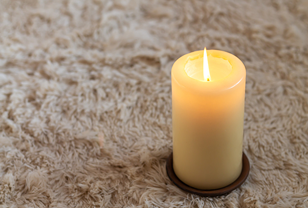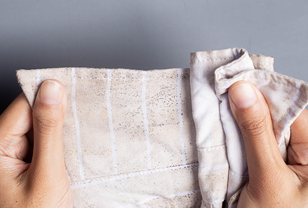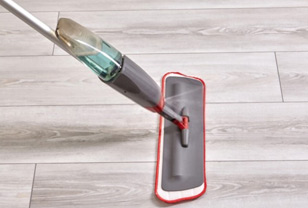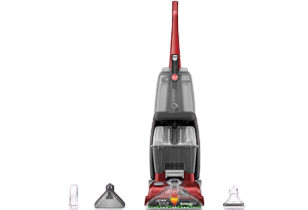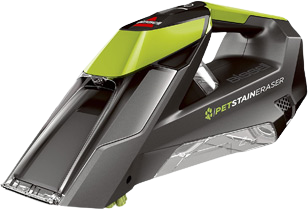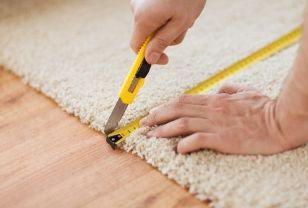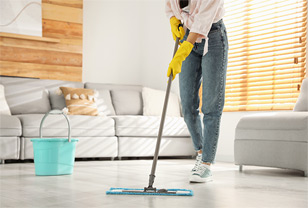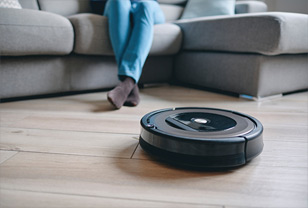Cleaning Laminate Floors With Vinegar: 5 Safe, Natural Steps to Bring Back the Shine
If that sounds familiar, cleaning laminate floors with vinegar can still be a safe, budget-friendly, non-toxic way to restore your floors – as long as you control two things: dilution and moisture.
If you want a natural, eco-friendly laminate floor cleaner that’s gentle enough for homes with kids and pets, a properly diluted vinegar mix is one of the simplest options you can make at home.
This guide is based on hands-on testing from TheKingLive’s cleaning team on real laminate flooring: older cloudy planks, busy hallways with kids and pets, wood-look laminate in floating floors, and humid apartments where drying time really matters. You’ll get:
-
Clear answers on when vinegar is safe (and when it’s not)
-
DIY vinegar recipes you can mix at home
-
A step-by-step routine you can copy today
-
Common mistakes to avoid and simple spot-cleaning tricks
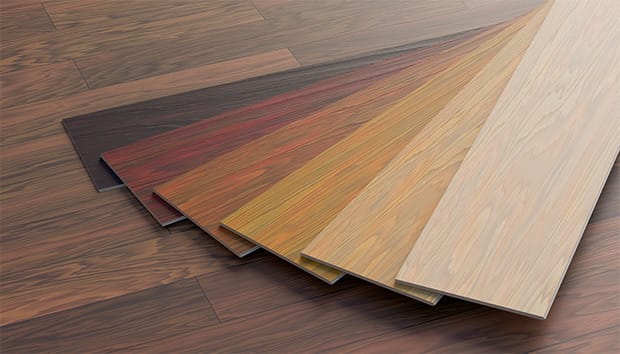
If you're looking for a natural, environmentally friendly laminate floor cleaning that's safe for families with children and pets
1. Quick Answer: How to Clean Laminate Floors With Vinegar (TL;DR)
If you only have a few minutes, start here.
1.1 Basic Vinegar Cleaner (For Routine Mopping)
-
Mix ½ cup distilled white vinegar + ½ cup filtered water in a spray bottle (1:1).
-
Lightly mist a small area of the floor (don’t soak it).
-
Wipe with a slightly damp microfiber mop.
-
Immediately dry and buff that area with a second, dry microfiber cloth.
This gives you a simple, non-toxic laminate floor cleaner that avoids harsh chemicals but still cuts through light grime and residue.
1.2 Golden Rules to Protect Laminate
-
Always use diluted white vinegar, never straight vinegar.
-
Work in small sections, not the whole room at once.
-
Keep your mop slightly damp, not dripping.
-
Always wipe and dry each patch before you move on.
-
If your floor is already swollen, warped, or soft, follow your manufacturer’s care guide first.
Do this once or twice a week, and your laminate – whether it’s a wood-look laminate floor in the living room or a floating laminate floor in the hallway – should stay clean, low-streak, and protected from moisture.
2. Is Vinegar Safe for Laminate Floors? Risks, Myths, and When It Works
Search online, and you’ll see two extreme opinions:
-
“Vinegar ruins laminate floors.”
-
“Vinegar is a miracle, use it for everything.”
Reality sits in the middle. Vinegar can help or harm laminate depending on how you use it.
2.1 Why Some People Say Vinegar Ruins Laminate
Laminate flooring – including click-lock laminate floors and floating laminate systems – has a wear (lamination) layer on top that protects the printed wood pattern underneath. That top layer is tough, but it isn’t indestructible.
Vinegar is made from acetic acid. Used the wrong way, it can cause problems:
-
Straight vinegar is too acidic and can slowly dull the finish.
-
Soaking the floor lets liquid seep into seams and edges, causing swelling or buckling.
-
Letting vinegar or any cleaner sit and dry on the surface can leave cloudy film or streaks.
When people pour vinegar directly on the floor, mop with a very wet mop, or skip the drying step, they can damage laminate over time.
Manufacturers often warn against excess moisture, steam mops, harsh alkaline cleaners, and strong acids for exactly this reason: anything that attacks the wear layer or pushes water into the core is risky.
2.2 Why Dilution and Moisture Control Make It Safe
Used correctly, vinegar becomes a gentle, natural floor cleaner that can:
-
Lift dust, light grime, and surface film
-
Break down sticky residue from old cleaners
-
Help reduce light cloudiness over several cleaning cycles
In TheKingLive’s tests on older laminate with light haze, a diluted vinegar routine used once or twice a week gradually:
-
Removed leftover product build-up
-
Made the surface look more even and less cloudy
-
Improved the “clean” look without stripping the finish
Most laminate manufacturers warn against harsh chemicals, steam, and excess moisture, not against properly diluted vinegar. A low-moisture vinegar routine respects those warnings when you:
-
Keep the mix gentle (diluted vinegar, never pure)
-
Use a lightly damp mop
-
Dry each section right after cleaning
For households that want a more eco-friendly alternative to heavy chemical cleaners, a diluted vinegar solution can be a safer middle ground, as long as it’s used with care.
Key idea: Vinegar is safe for laminate when you dilute it, mist lightly, and dry quickly. The danger is not vinegar itself, but too much acid or too much water sitting on the floor.
3. Step-By-Step Routine for Cleaning Laminate Floors With Vinegar Safely
Here’s a simple, repeatable routine you can use room by room.
3.1 Step 1 – Dry Clean First: Sweep or Vacuum Thoroughly
Before you grab the spray bottle:
-
Sweep or vacuum to remove dust, crumbs, pet hair, and grit.
-
Pay special attention to:
-
Room corners
-
Edges along baseboards
-
Under and around furniture
-
If you skip this step, tiny grit particles get pushed around by the mop and can scratch the protective layer on your laminate planks.
A few minutes of dry cleaning protects the finish and makes each wet pass more effective, especially in high-traffic areas like hallways and kitchens.

To get rid of grit, dust, crumbs, and pet hair, sweep or vacuum
3.2 Step 2 – Patch Test Your Vinegar Mix in a Hidden Area
Laminate from different brands – and even different lines of wood-look laminate flooring – can react slightly differently. Always test first.
Choose a hidden spot:
-
Behind a couch or cabinet
-
In a corner with low foot traffic
Then:
-
Lightly mist your vinegar cleaner on that area.
-
Wipe with a microfiber cloth or mop.
-
Dry the spot completely.
-
Wait a few minutes and check for:
-
Cloudiness
-
Peeling or softening
-
Discoloration
-
If anything looks wrong, stop. Either:
-
Weaken the mix (more water, less vinegar), or
-
Switch to a cleaner that your manufacturer labels as safe for laminate, such as a pH-neutral laminate floor cleaner.
One quick test can save your entire floor and keeps your cleaning routine low-risk.
3.3 Step 3 – Mist in Small Sections, Never Soak the Floor
Laminate and standing water do not mix – particularly with floating laminate floors where moisture can creep under the planks.
-
Work in small zones – about 1 square foot at a time.
-
Lightly mist the floor; think fine spray, not puddles.
-
Don’t spray the entire room and come back later. Vinegar solutions shouldn’t sit on laminate while you clean elsewhere.
If you’re using a deep-clean mix (with baking soda and soap), go even lighter. If it dries on the surface, it can leave a white haze that takes extra time to remove, especially when cleaning laminate floors with vinegar as part of a careful, low-moisture routine.
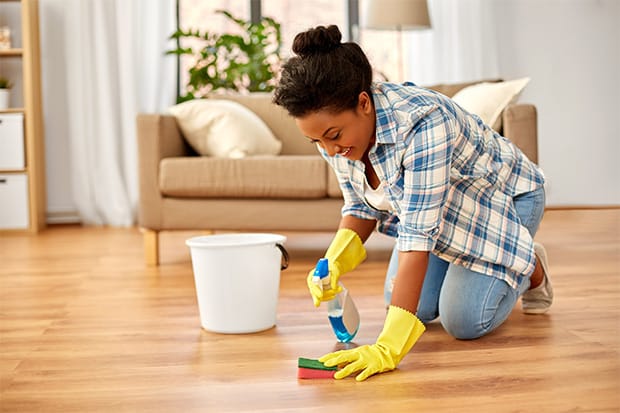
Go extra lighter if you're using a deep-clean combination (which contains soap and baking soda)
3.4 Step 4 – Wipe With a Slightly Damp Mop or Microfiber Cloth
Now you remove the loosened dirt.
-
Use a slightly damp, not dripping, microfiber mop or cloth.
-
Wring out excess water before you start.
-
Glide the mop in smooth passes to lift both dirt and cleaner.
-
Rinse and wring the cloth or pad whenever it starts to look dirty.
Your goal is simple: pick up the solution and soil, not push liquid deeper into seams or edges.
3.5 Step 5 – Dry and Buff for a Streak-Free Finish
Right after wiping each section:
-
Take a second, dry microfiber cloth or mop head.
-
Go over the same patch until it feels dry under your hand.
Drying:
-
Reduces the risk of water stains, swelling, and warping
-
Prevents dull patches and streaks
-
Adds a light buffing effect, evening out the sheen
In one hallway TheKingLive tested, the floor had heavy cloudy streaks from old polish. After three weeks of this quick “mist → wipe → dry → buff” routine with a basic vinegar and water floor cleaner, the haze was noticeably lighter, and the boards looked more even in natural light.
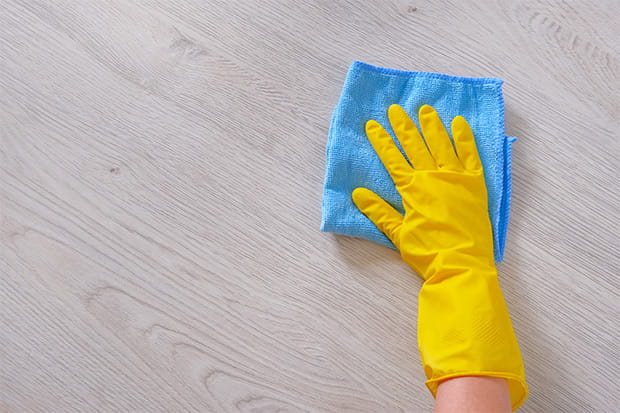
Take another dry mop head or microfiber cloth
4. Vinegar Cleaner Recipes: Everyday, Fast-Drying, and Deep Clean
Pick the recipe that matches your home and your floor’s condition. These are all easy homemade floor cleaner options you can mix in minutes.
4.1 Everyday Laminate Floor Cleaner: Vinegar and Water
Best for weekly cleaning when your laminate just looks a bit dusty or dull.
You’ll need:
-
1 spray bottle
-
½ cup distilled white vinegar
-
½ cup filtered or bottled water
-
A few drops of essential oil (optional)
Why filtered water helps: hard tap water can leave mineral deposits that dry into faint streaks. Using filtered or bottled water lowers that risk and helps the floor dry more evenly.
Optional scent: if you dislike the smell of vinegar, add a few drops of orange or lavender essential oil. They soften the scent without turning the cleaner into a heavy perfume.
How to mix:
-
Add ½ cup vinegar + ½ cup water (1:1 ratio) to the spray bottle.
-
Close and shake gently until combined.
This is your default natural way to clean laminate floors, perfect for a simple weekly routine that leans more eco-friendly and avoids aggressive chemicals.
4.2 Fast-Drying Cleaner: Vinegar and Rubbing Alcohol
Best when you need floors to dry quickly, especially in humid climates or high-traffic homes, and when cleaning laminate floors with vinegar is your preferred natural method but you still want faster evaporation.
You’ll need:
-
1 spray bottle
-
½ cup distilled white vinegar
-
½ cup rubbing alcohol
-
½ cup filtered or bottled water
-
Essential oil (optional)
How to mix:
-
Pour ½ cup water into the spray bottle.
-
Add ½ cup vinegar and ½ cup rubbing alcohol.
-
Close and shake to combine.
-
Add a few drops of essential oil if you like, then shake again.
Rubbing alcohol speeds up evaporation, which is especially helpful in:
-
Humid apartments
-
Small spaces with limited airflow
-
Busy kitchens and hallways
Choose this mix when your top priority is low moisture and quick drying, but still within a DIY, non-toxic cleaning routine.
4.3 Occasional Deep-Clean Mix: Vinegar, Baking Soda, and Dish Soap
Best for occasional deep cleaning when you have greasy spots, stuck-on grime, or older buildup.
You’ll need:
-
1 spray bottle
-
2 tablespoons distilled white vinegar
-
½ cup gentle dish soap
-
1⅔ cups baking soda
-
½ cup distilled or bottled water
-
Essential oil (optional)
How to mix:
-
In a bowl, combine:
-
2 tablespoons vinegar
-
½ cup gentle dish soap
-
1⅔ cups baking soda
-
½ cup water
-
-
Stir until the baking soda dissolves and the mixture is smooth.
-
Pour carefully into the spray bottle.
-
Add essential oil if desired.
This cleaner is thicker and more powerful. Use:
-
A light mist, not heavy sprays
-
The same “mist → wipe → dry” routine, but be extra careful not to let it dry on the surface
Think of this as your once-in-a-while heavy-duty option, not a weekly habit.
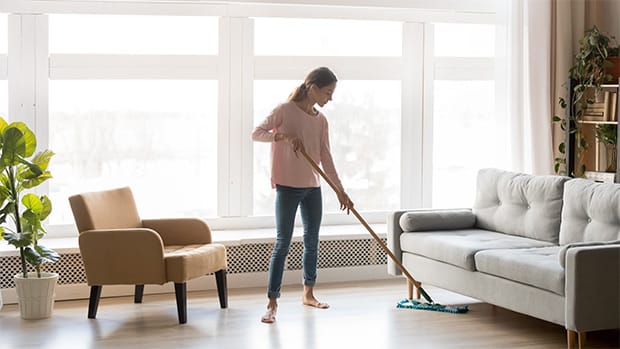
Wipe off the area you just sprayed with cleaner using a mop or a wrung-out microfiber cloth
5. Spot Cleaning Laminate Spills and Stains With Vinegar
You won’t always have time to mop the whole room. Sometimes you just need to fix one small mess.
5.1 Everyday Messes Vinegar Can Handle
A diluted vinegar spray works well on:
-
Fresh spills: juice, soda, wine
-
Dried mud or dirt
-
Light sticky or sugary residue
For ink, crayon, mold, large water stains, or serious pet accidents, vinegar alone is not enough. In those cases, follow your flooring manufacturer’s advice or use specialized products designed for laminate floor care.
This keeps your routine DIY and low-chemical for simple messes, while still respecting the limits of what a natural cleaner can do.
5.2 Stronger Stain-Fighting Vinegar Mix (For Small Areas Only)
For stubborn spots, use a slightly stronger mix that still stays safe when you work quickly:
-
In a spray bottle, mix 1 part vinegar + 3 parts water.
-
Shake to combine.
This ratio gives extra cleaning power on small stains as long as you:
-
Mist lightly
-
Scrub gently
-
Dry thoroughly afterward

Scrub and spray until the stain is gone
5.3 Three Quick Steps to Lift Stains Without Damage
-
Lightly mist the stain
-
Just dampen the area; do not soak the seams between planks.
-
-
Gently scrub
-
Use a damp microfiber cloth.
-
Rub in small circles to loosen the stain.
-
-
Dry completely
-
Switch to a dry cloth.
-
Wipe away any remaining moisture and cleaner.
-
Treat each stain as a tiny cleaning zone: brief contact, quick cleaning, fast drying.
6. Common Mistakes to Avoid When Using Vinegar on Laminate Floors
Even with the right recipe, a few habits can quietly damage laminate over time. Avoid these:
-
Using pure vinegar
-
Too acidic; can slowly dull the finish and exaggerate existing wear.
-
-
Soaking the floor
-
Puddles and dripping mops let water seep into seams and edges, causing swelling, buckling, and soft spots.
-
-
Letting cleaner sit and dry on the surface
-
Can cause haze, streaks, or powdery residue, especially with baking soda mixes.
-
-
Skipping the drying step
-
Leaving moisture behind is one of the fastest ways to damage laminate cores over months and years.
-
-
Using dark vinegars (like red wine or apple cider)
-
Pigments can lightly tint or stain lighter laminate designs.
-
-
Relying on a steam mop on laminate
-
Hot steam can force moisture into the joints of floating laminate floors, causing the core to swell and the boards to deform.
-
-
Layering vinegar on top of wax or traditional floor polish
-
Many waxes and polishes are designed for other floor types. Combined with vinegar, they can create sticky, cloudy build-up on laminate instead of a clear shine.
-
Stick to diluted distilled white vinegar, light misting, and thorough drying, and vinegar becomes a safe, predictable part of your laminate floor-care routine.
7. Safety Guidelines, Manufacturer Advice, and When to Call a Professional
Not all laminate flooring is made the same. Different brands use different cores, wear layers, and finishes.
Keep these safety points in mind:
-
Always follow your manufacturer’s care instructions first.
If their guide conflicts with any DIY advice, follow the manufacturer. Many brands recommend a pH-neutral laminate floor cleaner or a specific branded cleaner, and you should treat vinegar as a complementary option, not a replacement, in those cases. -
If your floor is already:
-
Severely swollen
-
Buckling or separating at the seams
-
Soft or spongy underfoot
it’s safer to call a flooring professional instead of experimenting with any homemade cleaner.
-
-
If you have sensitive skin, wear gloves when handling cleaners, including vinegar-based mixes.
-
Ensure good ventilation when you use rubbing alcohol or essential oils.
This routine follows low-moisture cleaning principles, real-world testing from TheKingLive, and basic home-maintenance best practices, but you should still adjust it to your specific floor and household.
8. Long-Term Laminate Care: Making Vinegar Part of Your Routine
Once you’ve tested your mix and dialed in your routine, cleaning laminate floors with vinegar can become a simple part of your regular home cleaning schedule and your broader green cleaning routine.
A realistic long-term plan might look like this:
-
Daily or every few days
-
Quick sweep or vacuum in high-traffic areas.
-
-
Once a week
-
Mop with the everyday vinegar + water mix.
-
Use the “mist → wipe → dry → buff” method.
-
-
Every few weeks or monthly
-
Use the fast-dry mix if your home is humid or you’ve had extra traffic.
-
-
Every few months or as needed
-
Use the deep-clean mix on stubborn buildup or greasy areas, then return to the gentler cleaner.
-
You can also alternate a vinegar-based cleaner with a pH-neutral laminate cleaner recommended by your manufacturer if you want to balance natural cleaning with warranty-friendly products.
If you’re renting, this low-moisture routine helps protect the laminate floor and your security deposit. If you own your home, it helps you delay costly replacement and keep floors looking good longer.
FREQUENTLY ASKED QUESTIONS
- 01. Which Type of Vinegar Is Best for Laminate Floors?
-
Use distilled white vinegar for cleaning laminate floors.
It has two big advantages:
- No added color, so it won’t tint or stain the floor.
- Stable, predictable acidity, so it’s easy to dilute and control.
Apple cider vinegar, red wine vinegar, and other dark vinegars contain pigments that can color light laminate designs. If you don’t have white vinegar, clear rice vinegar can work in a pinch, but distilled white is still the safest choice for a vinegar and water floor cleaner, especially if you want a simple, non-toxic cleaning solution.
- 02. Can Vinegar Damage Laminate If I Use It Too Often?
-
Vinegar can damage laminate if you:
-
Use it undiluted
-
Let it sit on the floor for a long time
-
Combine it with a lot of water and leave the surface damp
Used the right way – diluted, lightly misted, wiped, and dried promptly – a vinegar solution is a safe DIY laminate floor cleaner for most homes.
If you’re ever unsure, start with a weaker mix, do a patch test, and see how your specific floor reacts.
-
- 03. Is It Okay to Mop With Vinegar Every Time I Clean?
-
For most households, yes – as long as you:
-
Keep the ratio gentle (like 1:1 or 1:3 vinegar to water).
-
Avoid flooding the floor.
-
Always dry the surface as you go.
If your laminate flooring is brand new, high-gloss, or under warranty, check the manufacturer’s guide. Some brands prefer that you alternate vinegar mopping with plain water or a branded pH-neutral laminate cleaner.
-
- 04. Why Does My Laminate Floor Look Dull Even After Cleaning?
-
Common causes of dull laminate flooring include:
-
Wrong or heavy cleaners
-
Oil-based products, wax, or polish can leave a cloudy film.
-
Using too much cleaner (even the right one) can leave residue.
-
-
Too much moisture
-
Water can work its way through seams between planks.
-
Over time, boards may swell, buckle, or show water marks.
-
-
Sunlight
-
Constant direct sunlight can slowly bleach the color.
-
-
Pets and plants
-
Pet bowls dragged across the floor can scratch.
-
Water from plant pots can sit unnoticed and seep into the lamination.
-
A diluted vinegar routine can help remove residue and light buildup, but it can’t reverse long-term sun fading or serious water damage.
-
- 05. How Can I Make My Laminate Floors Shine Again?
-
To restore and maintain a healthy sheen:
-
Vacuum or sweep regularly
-
At least once a week to remove grit that can scratch the finish.
-
-
Mop with a vinegar-based cleaner
-
Depending on foot traffic, this could be once or twice every week.
-
Lightly mist, clean, and remove moisture right away.
-
-
Buff after mopping
-
Use a dry microfiber mop or cloth.
-
Buff the surface to smooth out light streaks and even the shine.
-
-
Skip wax and traditional floor polish
-
Many waxes and polishes are designed for other floor types.
-
On laminate, they often create a cloudy coating instead of clear gloss.
-
With a gentle vinegar mix, low moisture, and regular buffing, cleaning laminate floors with vinegar becomes a safe, natural way to keep your laminate smooth and bright without filling your home with harsh chemicals or a shelf of one-use products.
-
- 06. Can I Use a Steam Mop Instead of Vinegar on Laminate Floors?
-
Most laminate manufacturers do not recommend steam mops on laminate flooring, including floating laminate floors and click-lock systems.
Steam can:
-
Force hot moisture into plank seams and joints
-
Soften the core over time
-
Lead to warping, swelling, or surface separation
If you want a simple, eco-friendly cleaning routine, a low-moisture vinegar solution (or a manufacturer-approved pH-neutral cleaner) used with a microfiber mop is almost always safer than using a steam mop on laminate.
With the right dilution, technique, and expectations, vinegar can move from “confusing internet hack” to a reliable, natural part of your laminate floor-care routine.
-


